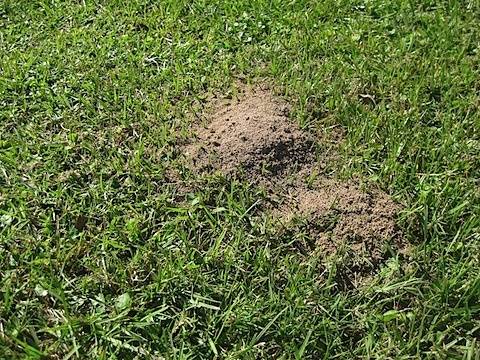Lawn ants can be a real nuisance, let’s take a look at what can be done to reduce their numbers.
Ants, like bees, live in a colony. An ant colony is made up of one or more fertile, egg-laying females and many hundreds, if not thousands of worker ants. The job of the queen, once she has mated, is to stay in the nest and lay eggs. The workers care for the queen and her eggs, protecting and feeding them. House-keeping the nest and foraging for food.
The eggs are laid deep down in the nest, in a specialised brood chamber. The tiny larvae are fed a liquid diet by the worker ants and when this stage of development is complete, they pupate before becoming adult ants – and the circle of life continues. At certain times of year some species of ants produce winged females en-mass which fly off in search of a mate and once mated then find a suitable place to establish their own colony. You’ve probably witnessed this phenomenon yourself, typically on a hot and humid summer’s day.
Why are ants in lawns a problem?
Most ants in the garden are more of a nuisance than a damaging pest. However, in the UK a number of garden ant species will attack when under threat. Whilst this is unlikely to cause anything more than an unpleasant reaction, it can certainly be enough to spoil a picnic or make you think twice before sitting on the lawn with bare legs. It can be particularly unpleasant for small children wanting to play outside.

Other than their bites or the spray of their acid, the other major concern that we come across related to ants in lawns is the damage they cause by bringing soil to the surface whilst excavating their nests. This causes two main problems – the first is that over time their excavations make the lawn uneven and cause ant-hills which are easily scalped as you mow the grass. Secondly the soil they bring to the surface is often flattened under foot or when mowing and can cause the grass to die back through lack of light. In both instances the result is a bare area ideal for the germination of weed seeds or moss spores.
Killing lawn ants
As gardeners we should be doing all we can to work with nature and not be heavy handed in our approach. However, focussed and specialist action against garden pests is certainly justified. Many gardeners attempt to deal with ants themselves and often do this with traps, powder or boiling water. All of which is relatively unsuccessful and runs the risk of killing more grass than it does ants. Remembering that the colony exists because of the egg-laying queen, unless she is eradicated then the colony will continue to function. Surface applied powders and traps are doing little more than killing worker ants. The queen continues to lay eggs and the many hundreds of workers still in existence continue to feed them.
How do lawn-care professionals manage a lawn ant problem?
Remember that an effective ant killer needs to kill the queen, deep in the brood chamber of the nest. We recommend the use of Ant Stop Granules. Follow the instructions on the pack to mix with water and apply as a drench to each any colony in the lawn. Poking deep holes into the nest will help the penetration of the drench.
Dealing with ant hills
If you do have ants bringing soil to the surface of your lawn, then try to redistribute the soil with a broom or besom before mowing. If you have a powerful leaf blower this can be really effective at blowing the mound of soil out from within the grass. If their excavations have made your lawn uneven this can be repaired by cutting and peeling back the turf before making levels good again and treading the turf back in place. Remember to water it in well.
Attempts of getting rid of lawn ants are not as simple as you may think and you may actually make the situation worse. Asking a lawn care professional to help with the problem and ensuring any insecticides are applied safely will get the results you are looking for.
Please remember that anyone using pesticides in your garden on your behalf must be licenced. If they are not then you are both breaking the law.

 Established 2016
Established 2016



